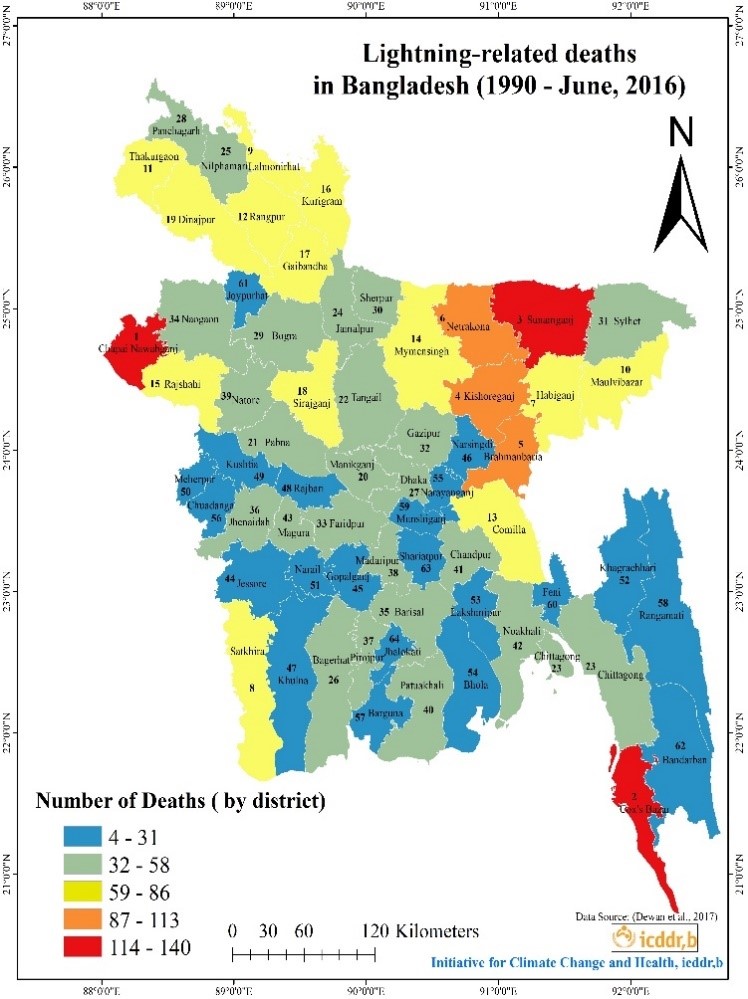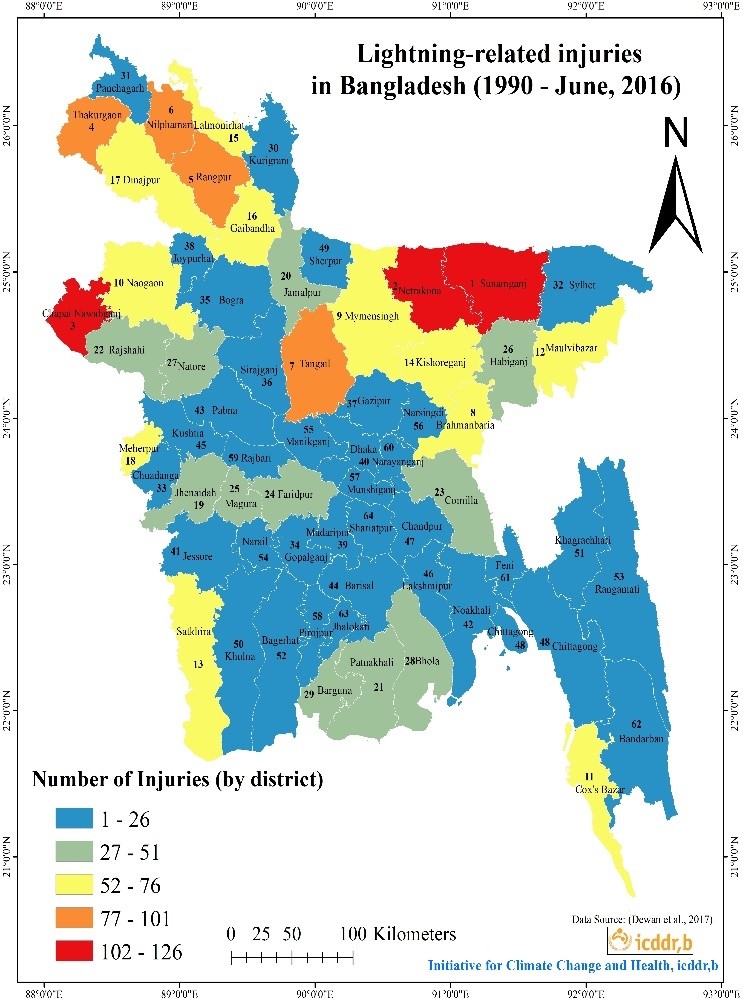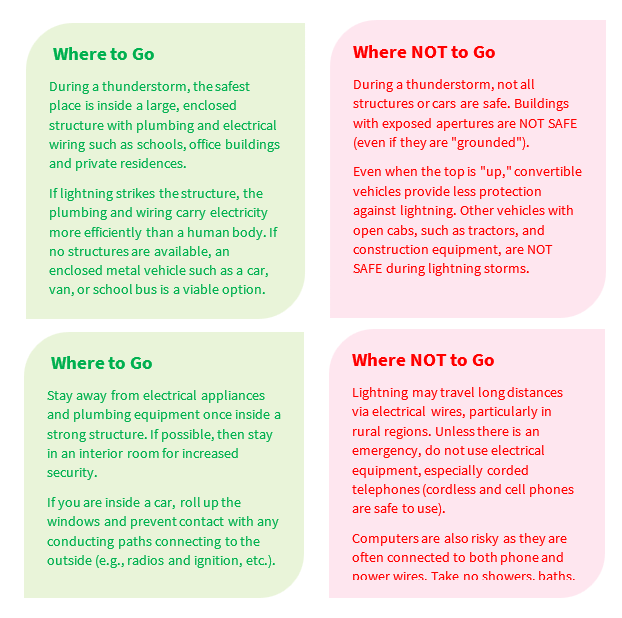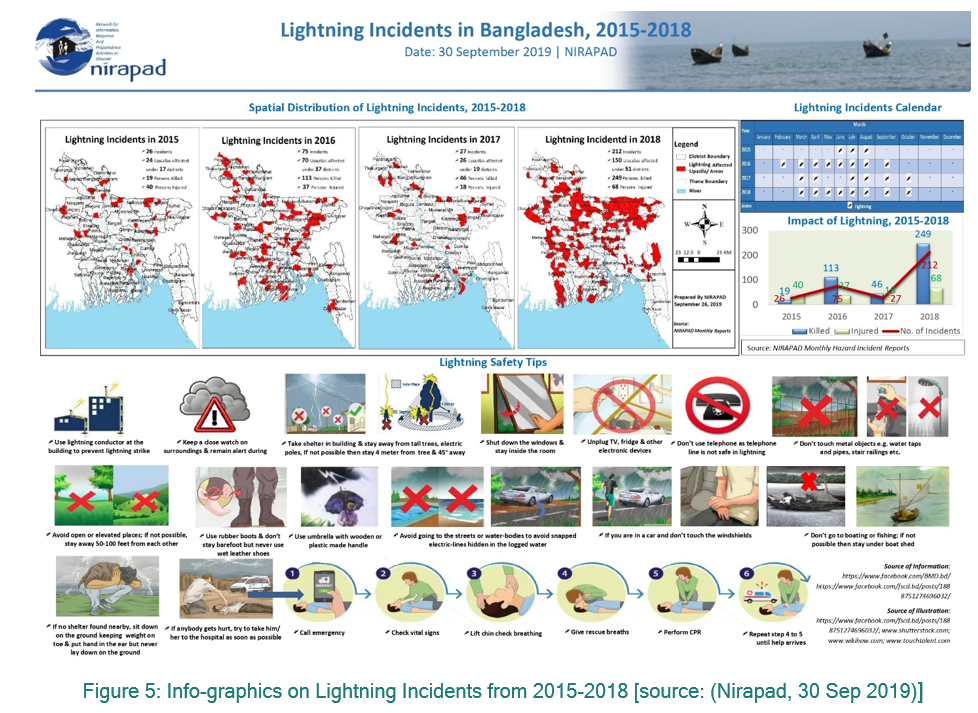There are 60 lightning strikes worldwide every second, adding up to about 1.4 billion strikes annually [1]. About 25 million lightning strikes happen on Earth every year. If the air temperature around the world goes up by 1°C, there will be 12% more lightning [2]. Between 2010 and 2020, lightning killed 3,273 people in Bangladesh, or about four people a week [3]. In 2021, there were 5,757,836 lightning counts in Bangladesh, with 42.44 lightning events per km2 [4]. Bangladesh will have many more lightning strikes that will kill people because of global warming and climate change.
Lightning
The energy sources of lightning and thunder are distinct: electrical and sound energy, respectively. Lightning is a sudden, straight or branched electrical discharge in the sky. Lightning is a short, visible electrical discharge resulting from an electrical imbalance between a storm cloud and another surface, such as the ground or another cloud. Lightning strikes are extremely hot and can boost the surrounding air temperature to five times that of the sun's surface [5]. As a result of the quick expansion and vibration of the surrounding air, we hear thunder shortly after observing a lightning strike. As one of the leading causes of weather-related mortality following hurricanes, tornadoes, and flash floods [6], lightning-related injuries constitute a grave threat to world health. Climate change's irregular patterns are causing more water to evaporate from land surfaces and oceans, increasing the likelihood of more clouds, precipitation, and lightning storms. The world is progressively warming and undergoing unprecedentedly violent lightning storms. Due to its significance, the government of Bangladesh has defined lightning strikes as an official form of natural catastrophe since August 2016 [7].
Formation of Lightning Mechanism
Lightning is produced by electric discharges from clouds and the earth. A single lightning strike may heat the surrounding air to 54,000 degrees Fahrenheit (30,000 degrees Celsius) [8]. Due to the extreme temperature, the air expands explosively quickly, causing a gigantic explosion that transforms into the loud sound wave known as thunder. Typically, lightning is connected with thunderstorms. According to the National Oceanic and Atmospheric Administration (NOAA), the conditions required to create lightning are widely understood; nonetheless, scientists have never pinpointed the precise cause for its genesis. Recent research has shown that ice, semi-frozen water droplets, and hail are necessary for lightning to occur. Storms that do not create a substantial volume of ice seldom produce lightning. Moving thunderstorms form pools of positively charged particles that the storm transports (image 1). A negative charge channel, often known as a "stepped leader," will descend from the storm's lowest point to the earth. As the differences in charges rise, particles with positive charges from the ground ascend via higher things such as trees, houses, and telephone poles (image 2). This process occurs so swiftly, in less than the blink of an eye, that it is almost impossible for human eyesight to detect. (picture 3). The transfer of electricity that happens when these channels intersect is what the human eye perceives as lightning. When the negative leader strikes the ground, a positive charge builds up in the ground and the objects on it. Thus, the positive charge combines with the negative charge's channel to create lightning (picture 3) [9].

Figure 1: Lightning develops between the cloud and the ground (source: NOAA [8])
Different types of lightning
The cloud is traversed by lightning, which typically originates within a thunderstorm. Its existence can be constrained by the clouds, or it can wander through the open air until it is eventually crushed by the earth. The most common types of lightning, according to the Royal Meteorological Society, are [10]:
a. Cloud-to-Ground (CG) Lightning
b. Cloud-to-Air (CA) Lightning
c. Ground-to-Cloud (GC) Lightning
d. Intracloud (IC) Lightning
e. Cloud-to-Cloud (CC) Lightning (or intercloud lightning)

Figure 2: Different form of lightning (Source: Royal Meteorological Society [9])
Impacts of Lightning Strikes
Approximately 2,000 individuals per year are killed by lightning globally [5]. Hundreds more survivors are afflicted with life-altering conditions such as memory loss, vertigo, weakness, paralysis, and others. Strikes are capable of causing heart arrest and severe burns. Farmers, fisherman, and workers who work beneath the open sky, as well as residents of disadvantaged communities, are more susceptible to lightning strikes.
There are a variety of effects that lightning can have on the environment and man-made constructions. Among the most notable effects are:
It is difficult to prevent lightning strikes, as lightning is a natural occurrence. However, it is feasible to limit the danger of damage and injury by taking the necessary precautions, such as avoiding outdoor activities during thunderstorms and unplugging electrical appliances during a storm.
Lightning in Bangladesh
In many developing countries, it is very hard to figure out how many people died or were hurt because of lightning strikes. Before 89 people were killed by lightning on May 12 and 13, 2016, no government agency in Bangladesh kept track of lightning deaths. From 1990 to mid-2016, Dewan et al. found that there were a total of 5,468 casualties in Bangladesh, including 3,086 deaths and 2,382 injuries, with an average of 114 deaths and 89 injuries each year [12]. Holle et al. added 18 months of new data to Dewan's research, from the middle of 2016 to the end of 2017 [13]. Figure 3 shows the trends in lightning-related deaths and injuries from 1990 to 2017. Holle et al. figured out how many people have died and been hurt by lightning over the past 10 years.
There are more deaths (1,916) during the pre-monsoon season than during any other season. The monsoon season has the second highest number of fatalities (998), while the winter season has the lowest number of fatalities (45).

Figure 3: Number of lightning-related fatalities and injuries in Bangladesh from 1990 through 2017. Source: [11,12].

Figure 4(a): District-wise lightning-related deaths from 1990 to June 2016. Color shading in scale ranges from the highest in red to the lowest in blue. Data source: (3)

Figure 4(b): District-wise lightning-related injuries from 1990 to June 2016. Color shading in scale ranges from highest injury in red to lowest in blue. Data source: (Dewan et al., 2017 [11])
Lightning Safety Guidelines
Lightning is the weather threat that is least reported and studied [9]. It is one of the most unpredictable and random components of a thunderstorm. As a result, lightning alert/alarm systems are largely inefficient or nonexistent in numerous nations, including Bangladesh. Knowing and following established lightning safety principles can drastically reduce the risk of injury or death.

WARNING...When thunder roars, go indoors and stay there until 30 minutes after the last clap of thunder (National Weather Service, NOAA).
Precautions to Prevent Lightning-Related Deaths
The government of Bangladesh made the initiative to plant palm trees (Arecaceae) along roadways, which will serve as lightning conductors (rods) for broad rural open spaces. Recently, the Bangladesh Meteorological Department (BMD), in partnership with the National Aeronautics and Space Administration (NASA), implemented a lightning strikes early-warning system at the national level that could offer lightning forecasts up to 54 hours before a lightning strike [3]. However, its effectiveness has yet to be demonstrated, as it resembles a thunderstorm warning. In 23 lightning-prone districts, the Ministry of Disaster Management and Relief plans to install 723 early warning devices and construct 1,000 lightning-resistant concrete shelters [14]. The Nepalese government chose a lightning arrester as a precautionary step a few years ago and has had exceptional success installing them. Bangladesh's National Plan for Disaster Management (2016-2020) took action and made investments to comprehend the lightning disaster risk [15 such as:
Research Gaps
There is no spatial or temporal lightning early warning system in Bangladesh. The nation lacks any lightning safety plans, strategies, or policies. No lightning shelters are available for extremely vulnerable areas. Other than Dhaka Medical College, there are no other medical facilities with upgraded burn units. The majority of health care facilities (particularly in lightning-prone areas) lack the infrastructure to treat patients with internal or neurological injuries and serious burns who have been struck by lightning. In addition, there are no emergency hospital protocols for treating lightning-struck individuals for medical doctors and public health workers. There is no comprehensive lightning database or vital registration system in Bangladesh.

For more details data on Lightening, please visit the link below:
https://www.nirapad.org.bd/home/resources/monthlyHazard
References
16.Nirapad. (30 Sep 2019). Info-graphics on Lightning Incidents from 2015-2018. https://www.nirapad.org.bd/home/resources/hazardSituation
This website was produced with the support of the United States Agency for International Development (USAID) under the terms of USAID's Research for Decision Makers (RDM) Activity cooperative agreement no. AID-388-A-17-00006
Views expressed herein do not necessarily reflect the views of the U.S. Government or USAID. icddr,b is also grateful to the Governments of Bangladesh, Canada, Sweden and the UK for providing unrestricted/institutional support
68, Shaheed Tajuddin Ahmed Sarani Mohakhali, Dhaka 1212, Bangladesh
icddr,b is located at the Mohakhali area in Dhaka, just ask your driver for the "Cholera Hospital"
